Year 10+ Plane Geometry
Chapters
Properties of Regular Polygons
Properties of Regular Polygons
A polygon is any plane (flat) shape with straight edges.
A regular polygon is a polygon with
- All sides of equal length.
- All angles the same size.
Polygons that are not regular are called irregular
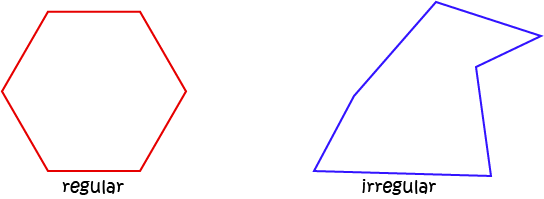
Exterior Angles of Polygons
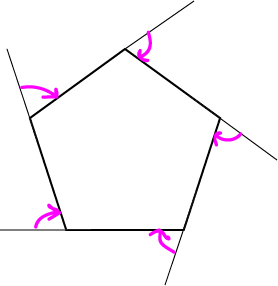
Exterior angles are angles that lie between a line extended from one edge of the polygon and the next edge (moving clockwise) as shown
in the picture.
No matter how many sides a polygon has, its exterior angles add up to \(360^\circ\)
So, each exterior angle of a regular polygon with \(n\) sides is equal to
Example
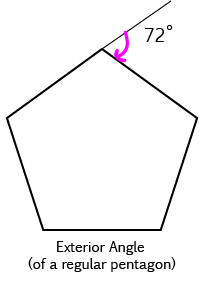
A pentagon has 5 sides, so each exterior angle of a regular pentagon is equal to
Interior Angles of Polygons
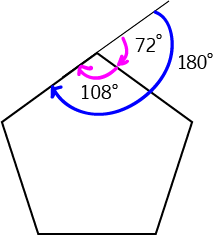
The interior angles are the ones inside the polygon between two adjacent edges. As the interior and exterior angles lie on the same
straight line, they add up to \(180^\circ\).
Let's work out the sizes of the interior angles in a regular polygon with \(n\) sides:
Example
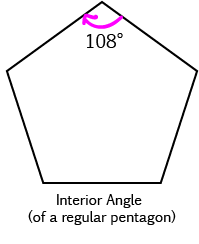
A pentagon has 5 sides, so each exterior angle of a regular pentagon is equal to
Example:
Find the interior and exterior angles of a regular decagon.

A decagon has 10 sides, so each exterior angle of a regular pentagon is equal to
Secret Regular Polygon Business
Not really secret, but there is special terminology associated with regular polygons that you may not have heard before.
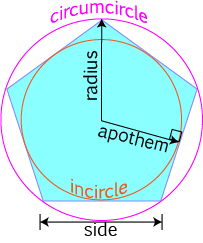
A circle drawn around a regular polygon that passes through all of its vertices is called a circumcircle. It is the smallest circle you can draw
around a polygon.
The largest circle you can draw inside a regular polygon touches each side exactly once (at its midpoint). It is called an incircle.
The radius of the circumcircle is also called the radius of the polygon.
The radius of the incircle is called the apothem of the polygon.
Polygons and Triangles
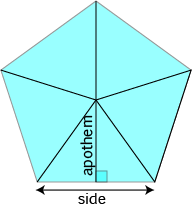
We can split a regular polygon with \(n\) sides up into \(n\) triangles as shown in the picture on the left.
The base of each triangle is equal to the side-length of the polygon.
The other two sides are equal to the radius of the polygon.
The height of each triangle is equal to the apothem of the polygon.
We can find the area of each triangle, and then multiply by \(n\) to give a formula for the area of the polygon:
More Area Formulas
Each triangle is cut in half by the apothem:
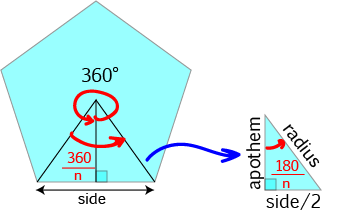
The smaller triangles formed like this are right-angled triangles because the apothem is the perpendicular bisector of the side of the polygon.
As the polygon can be split up into \(n\) triangles, the apex angle of the larger triangle is \(\dfrac{360^\circ}{n}\). So, the apex angle of the right-angled triangle is \(\dfrac{1}{2} \times \dfrac{360^\circ}{n} = \dfrac{180^\circ}{n}\).
We can use the right-angled trigonometric ratios to find relationships between the side, radius, apothem and \(n\) for the polygon.
- Using \(\sin \left(\dfrac{\pi}{n}\right) = \dfrac{\text{side}/2}{\text{radius}}\) gives \(\text{side} = 2 \times \text{radius} \times \sin \left(\dfrac{\pi}{n}\right)\).
- Using \(\cos \left(\dfrac{\pi}{n}\right) = \dfrac{\text{apothem}}{\text{radius}}\) gives \(\text{apothem} = \text{radius} \times \cos \left(\dfrac{\pi}{n}\right)\).
- Using \(\tan \left(\dfrac{\pi}{n}\right) = \dfrac{\text{side}/2}{\text{apothem}}\) gives \(\text{side} = 2 \times \text{apothem} \times \tan\left(\dfrac{\pi}{n}\right)\).
Using these relationships, we can find some more formulas for the area of the polygon.
If We Only Know the Apothem
The area of the smallest triangle is given by
From above, we know that
Since the whole polygon is made up of \(2n\) smaller triangles, the area of the polygon is given by
We can find other formulas involving only the radius or the side using a similar approach. They are:
We can find other formulas involving only the radius or the side using a similar approach. They are:
The table below shows the angle sums of polygons of various sizes, and the sizes of the interior angles of various polygons:
| Name of Regular Polygon | Number of Sides | Picture | Interior Angles | Radius | Side | Apothem | Area |
|---|---|---|---|---|---|---|---|
| Equilateral Triangle | 3 |  |
\(60^\circ\) | 1 | \(\sqrt{3} \approx 1.732\) | 0.5 | \(\dfrac{3}{4}\sqrt{3} \approx 1.299\) |
| Square | 4 |  |
\(90^\circ\) | 1 | \(\sqrt{2} \approx 1.414\) | \(\dfrac{1}{\sqrt{2}} \approx 0.707\) | \(2\) |
| Pentagon | 5 |  |
\(108^\circ\) | 1 | 1.176 | 0.809 | 2.378 |
| Hexagon | 6 |  |
\(120^\circ\) | 1 | 1 | \(\dfrac{1}{2}\sqrt{3} \approx 0.866\) | \(\dfrac{3}{2} \sqrt{3} \approx 2.598\) |
| Heptagon (or Septagon) | 7 |  |
\(128.57\dots^\circ\) | 1 | 0.868 | 0.901 | 2.736 |
| Octagon | 8 |  |
\(135^\circ\) | 1 | 0.765 | 0.924 | 2 \sqrt{2} \approx 2.828 |
| Nonagon | 9 |  |
\(140^\circ\) | 1 | 0.684 | 0.940 | 2.893 |
| Decagon | 10 |  |
\(144^\circ\) | 1 | 0.618 | 0.951 | 2.939 |
In general, as the number of sides becomes larger, and the radius is fixed at \(1\):
- The length of the sides gets smaller (approaches zero)
- The length of the apothem approaches 1 (which is the radius)
- The area of the polygon approaches \(\pi = 3.14159\dots\)
This is because, as we add in more sides, the polygon becomes more like a circle of radius 1, which has area \(\pi (1)^2 = \pi\). As the sides get shorter, the apothem gets closer and closer to the radius of the polygon (which is also the radius of the circle that the polygon is approaching).
Description
In these chapters you will learn about plane geometry topics such as
- Area (Irregular polygons, plane shapes etc)
- Perimeter
- Conic sections (Circle, Ellipse, Hyperbola etc)
- Polygons (Congruent, polygons, similar, triangles etc)
- Transformations and symmetry (Reflection, symmetry, transformations etc)
etc
Even though these chapters are marked for Year 10 or higher students, several topics are for students in Year 8 or higher
Audience
Year 10 or higher, suitable for Year 8 + students as well.
Learning Objectives
Learn about Plane Geometry
Author: Subject Coach
Added on: 28th Sep 2018
You must be logged in as Student to ask a Question.
None just yet!